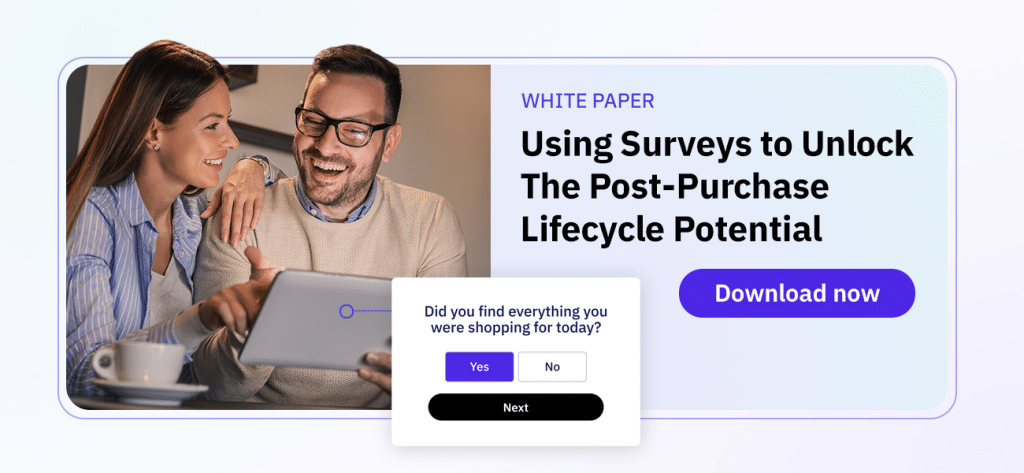
- Customer Marketing
- Partners
- Product
Okendo Evolve: Highlights of the Customer Marketing Roadshow
Megan Wenzl | Nov 29, 2023
Dec 20, 2022 | 6 minute read

Lindsay Kolinsky
Director of Marketing
In our last blog, we covered the importance of deploying a high-impact tech stack at the post-checkout buying stage in order to capitalize on the opportunity that exists after a customer makes a purchase.
One of the areas we highlighted was the use of post-checkout surveys to collect highly actionable insights from customers.
With their 50%+ response rates, these surveys have become a crucial piece of enabling brands to transform the way they collect zero-party data (ZPD) and create more personalized offerings in non-intrusive ways.

While the idea of a post-checkout survey may seem straightforward, the truth is that they’re not all created equal. Indeed, many leave a lot on the table when it comes to maximizing their potential to uncover the insights needed to scale a modern ecommerce business.
The reason why most surveys fail is pretty simple—they erode the customer experience (CX). This can happen by making customers jump through unnecessary hoops to provide feedback. By keeping the customer experience at the center of your post-checkout survey strategy, you optimize your opportunity to collect insightful and actionable feedback.
With that in mind, we’ve highlighted some best practices examples below to inspire your brand’s post-checkout experience.
Today’s consumers expect convenience and speed. Offer them anything else, and they’ll go elsewhere to find it.
In-moment micro-surveys are a great way to meet these demands and collect insightful and actionable customer feedback. These surveys consist of one to three questions delivered at highly relevant moments. This means that you can maximize engagement and ensure you’re meeting the expectations of your customers at the same time.
Answering a question like “How Did You Hear About Us?” by simply clicking on the option that represents the channel that drove their awareness takes a matter of seconds. Same with clicking through prepopulated demographic information for profile completion. This ease is why consumers love micro-surveys. Ecommerce brands love them because they can collect feedback in real-time, and use it to optimize their offerings and create better overall customer experiences.
Mobile retail ecommerce sales in the United States are projected to surpass 430 billion U.S. dollars by the end of this year. With a large percentage of your customer journeys taking place on mobile devices, every stage must be designed with today’s on-the-go consumer in mind. This includes your post-checkout surveys.
For example, when optimizing a survey for mobile, you must account for the complexities of screen size and operating systems. This means opting for concisely written questions and answers versus large matrix questions, limiting the number of open-ended questions, and being extremely cautious with how and where you use images and videos (such as logos).
Creating a great customer experience necessitates that all interactions you have with your customers are designed in a cohesive way that mirrors brand attributes. This is no different with post-checkout surveys; from ensuring the templates you choose weave in brand design elements (colors, logos, etc.) to ensuring the questions you ask use a similar tone as the rest of your content, make sure your surveys are pulling through a consistent brand experience.
Customers feed off familiarity. And when your identity shines at every touchpoint of the customer journey, it makes for a more uniform and engaging user experience. In fact, recent research shows that the consistent presentation of a brand can increase revenue by 33%. Indeed, designing a consistent brand experience has a residual impact on consumers. It’s important that this brand harmony carries through to the post-checkout survey stage, so consumers can quickly and seamlessly submit their feedback.
Many surveys don’t account for the exact state a customer is in when they are asked for feedback. Your repeat customers shouldn’t be asked to take the same post-purchase survey every time they make a purchase. Similarly, you shouldn’t be asking for answers to questions you should already know. Okendo Surveys’ tools allow you to collect in-moment insights to build out customer profiles before they check-out so you’re only drilling into the areas you need once a purchase is made.
There may be no stupid questions, but there are smarter ones when it comes to gathering insights. Solutions like Okendo Surveys automate your ability to drill down into the performance of specific channels and campaigns with easy-to-use Question Logic tools.
And while measuring key metrics like NPS, CES, and CSAT require you to stick to certain frameworks, there are plenty of areas where you can customize creative ways to elicit insightful feedback. One way to do this is by asking open-ended questions to draw out information about aspects of your business you might have never considered. Every customer is different and so is every transaction—use the flexibility that customizable post-checkout surveys provide to account for this.
Post-checkout surveys let you create better experiences for your customers. But in reality, many customers don’t take them with this in mind. Rewarding your customers for their feedback not only leads to higher response rates, but it shows that you value their insights.
With Okendo Surveys, ecommerce brands can configure a survey to reward customers when they complete it. Not only does this increase the chances that participants will complete your survey, but it has the potential to drive new sales with things like unique discount coupons for use toward a future purchase.
In order to make sure your post-checkout survey is as convenient as possible for customers, you’ll want to see what they see. With Okendo Surveys, teams get an interactive preview that allows them to see the exact experience their customers will have when they take the survey.
This is an imperative step as it helps you to make sure all the best practices outlined above are accounted for in your post-checkout survey experience. For example, you can test to ensure your surveys pull through a consistent brand design and are optimized for mobile. A good tip here is to get internal stakeholders involved by sending them the survey link first to check for spelling errors and question flow.
An enormous amount of effort goes into leading customers from the initial stages of the buyer’s journey to the post-checkout stage. But the post-checkout phase isn’t the finish line. In many ways, it’s only the beginning—and a critical step in turning first-time customers into repeat customers.
Related articles
Ready to learn more?